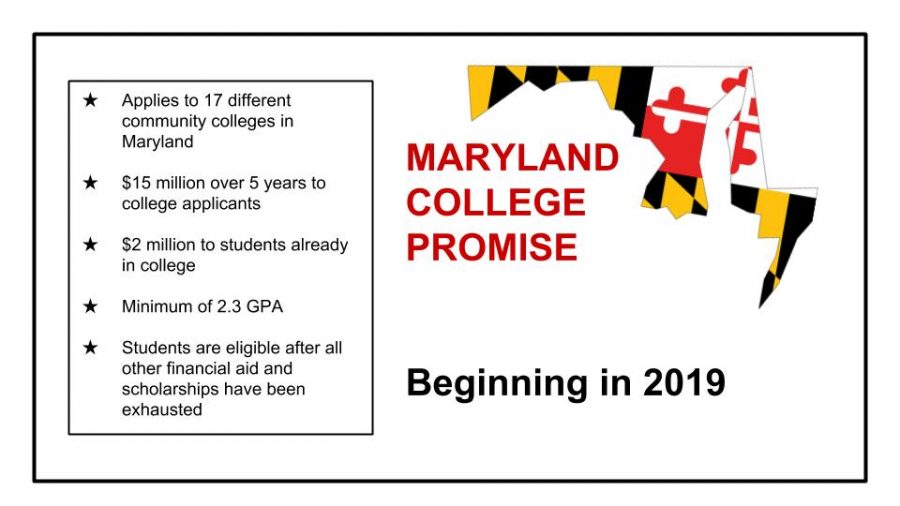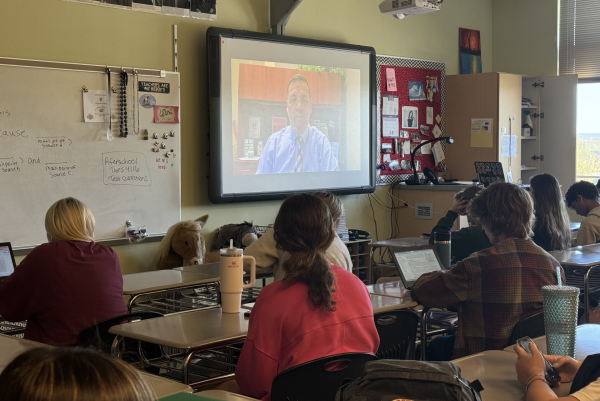Maryland Community College Promise Scholarships Bill creates hope for future of higher education
May 24, 2018
In Maryland, about 64% of high school graduates directly move on to college or university education. Out of this 64%, only 14.5% will graduate a 2-year college on time. Thanks to a new bill signed by Governor Larry Hogan, those students who aren’t able to finish college on time due to finances will have something to look forward to.
Approved by members of the General Assembly on April 9th, the bill provides free community college tuition to high school students who meet the requirements. The bill will require $15 million of state spending per year to provide this tuition. This money will come from the $700+ million tax dollars that Governor Hogan signed off on during the General Assembly, funding education aid across the state.
Long-term educational aid has been a part of Hogan’s plan since he entered office as governor. His spokesperson recently said, “The governor remains committed to helping more students achieve their educational goals and looks forward to signing this bill into law.”
To be eligible for the proposed free tuition, applicants must finish high school or obtain a GED. They must have a non-weighted grade point average of at least 2.3. They must also take at least 12 credit course hours, which requires a student to be enrolled full-time in community college.
There are income requirements set for applying for free tuition. A student living in a single-parent home must not live in a household that makes over $100,000 a year, while a household with two parents cannot make more than $150,000 a year.
Although the bill will not go into effect until 2019, students who will attend community college before then will not miss out on the opportunity for free tuition. The bill also pledges $2 million a year to help students that are already in community college.
The introduction of free college tuition to Maryland is not something new. Similar programs have been implemented in states such as New York, Oregon, Rhode Island, Montana, Minnesota, Kentucky, Arkansas, and Nevada. All of these states, similar to Maryland, pay for the tuition with tax dollars. Something important to note is that this tuition is provided after all other financial aid and grants have been exhausted for a student.
There are 17 state community colleges. According to school counselor Ilana Blum, 31% of LHS senior students will be attending FCC next year. Students are encouraged to apply to community colleges in their own county because the cost of tuition is based on residency.
Statistics from Blum show that 15% of the graduate Class of 2017 did not attend college. Seven percent of these students went on to learn different trades. Many students don’t realize is that FCC offers trade classes similar to the Career and Technology Center (CTC) for current high school students. FCC offers a variety of short-term training courses such as real estate certification, computer graphics, culinary skills, accounting, and child care.
It is one of the hopes of the bill to increase community college attendance. Elizabeth Duffy, Dual Enrollment Director for FCC, shares the same hope. “Hopefully, students who were on the fence about attending college may be more likely to attend if cost isn’t a factor. ”
The tax dollars that will be needed to pay for the tuition could have some people feeling skeptical about whether free tuition is really necessary. However, Class of 2017 Linganore graduate Emma Ruch, who attends FCC full-time, said, “I think that free community college tuition would be really helpful for a lot of students struggling financially and could make people work harder.”
Free community college tuition will grow the local community college. Duffy said, “I believe the college will have to increase the number and types of courses that we offer to meet the academic needs or interests of a growing student population.”
Free tuition for community college has only been relevant in recent years, dating back to its inclusion in former President Barack Obama’s State of the Union Address in 2015. With the addition of free community college tuition in more states every year, education across the country will become more common after high school.














